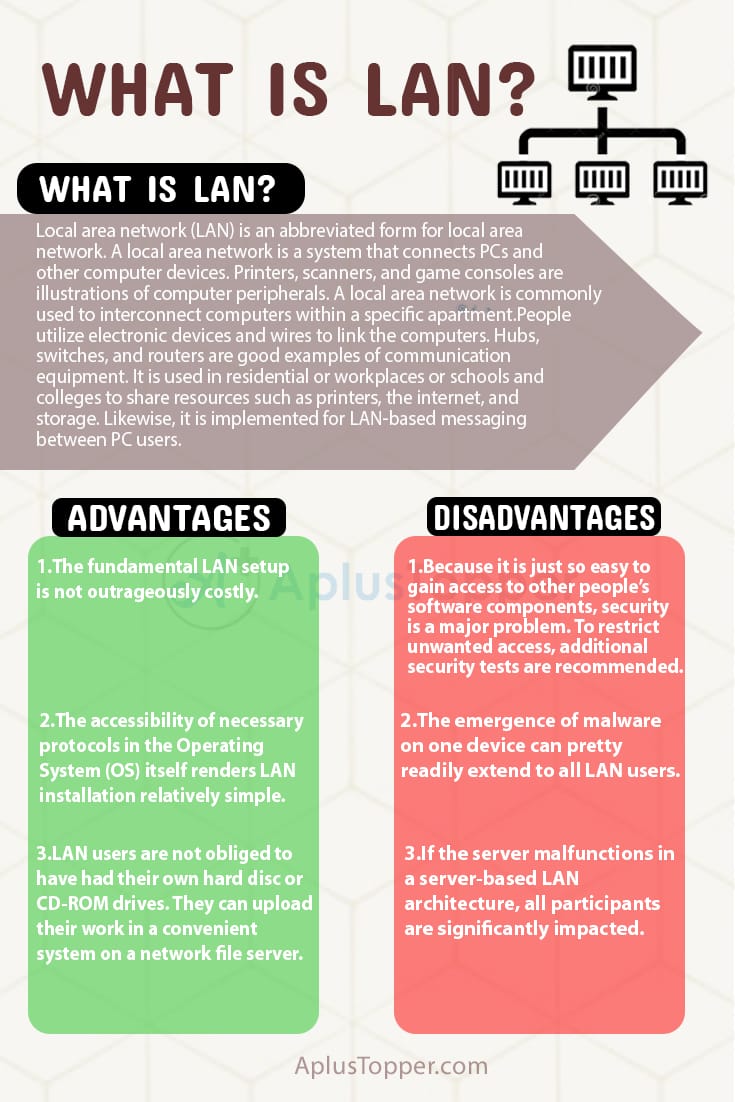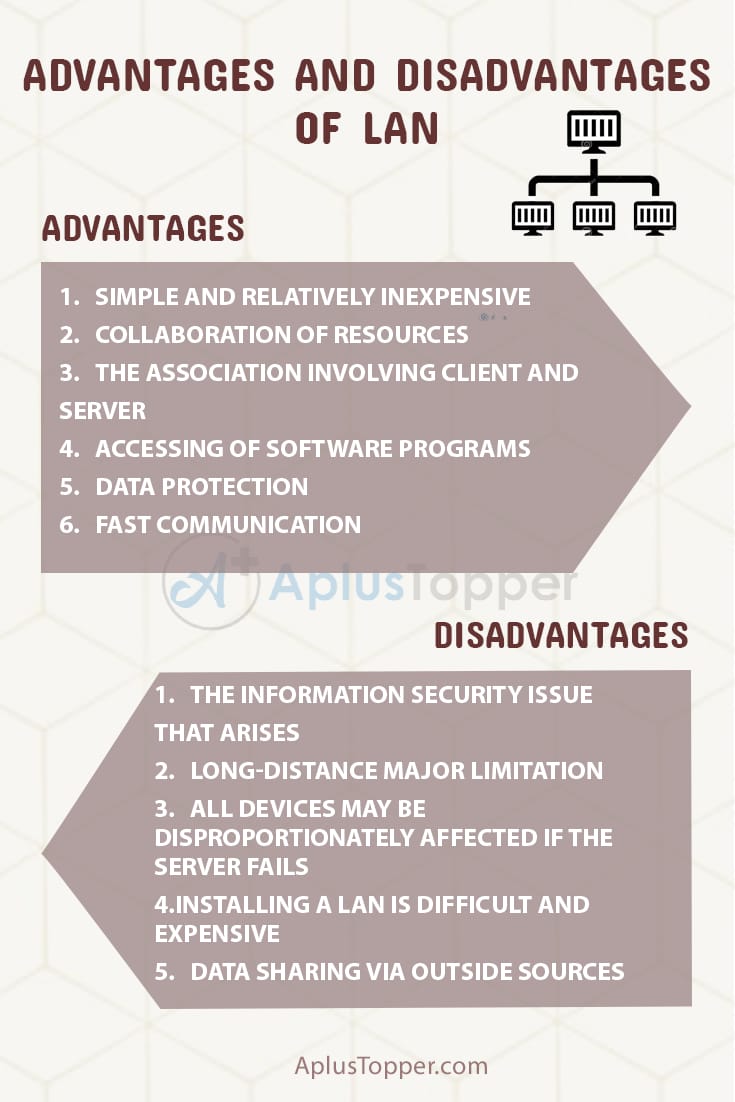LAN Advantages and Disadvantages: LAN may be equated to a toy train in that it has multiple coaches coupled to it and moves on a rail that is circular in form and therefore cannot transit outside of that route.
Likewise, LAN refers to a system that unites a collection of computers inside a certain physical territory. In the context of LAN, a bunch of computers is like a railway, and the network is like a part of the track; thus, computers cannot run further than the track, which is outside the network.
Students can also find more Advantages and Disadvantages articles on events, persons, sports, technology, and many more.
What is LAN? Advantages and Disadvantages of LAN 2021
Local area network (LAN) is an abbreviated form for local area network. A local area network is a system that connects PCs and other computer devices. Printers, scanners, and game consoles are illustrations of computer peripherals. A local area network is commonly used to interconnect computers within a specific apartment.
People utilize electronic devices and wires to link the computers. Hubs, switches, and routers are good examples of communication equipment.
It is used in residential or workplaces or schools and colleges to share resources such as printers, the internet, and storage. Likewise, it is implemented for LAN-based messaging between PC users.
In this post, we discussed at length some of the upsides and downsides of LAN.
- Advantages of LAN
- Disadvantages of LAN
- Comparison Table for Advantages & Disadvantages of LAN
- FAQs on Pros & Cons of LAN

Advantages of LAN
- Simple and relatively inexpensive: The primary benefit of a local area network is that this is quick and easy to set up and reasonably priced when contrasted to other alternatives; consequently, if an organization intends to build a network at a minimal price and with flexibility, a local area network is the ultimate answer.
- Collaboration of Resources:Expensive components such as printers and scanners cannot be linked to every desktop since it will indeed be very burdensome for the company, but thanks to local area networks, a corporation only clearly need one printer and scanner, and everybody can link to that printer and scanner and sends instruction from their machines, leading in meaningful cost savings for the corporation.
- The association involving client and server: All information from connected PCs may be maintained on a single server. If a machine (Client) demands information, the client may effortlessly log in and retrieve the information from the system. Films and albums, for instance, can be maintained on the server and retrieved by any approved user (Client computer).
- Accessing of software programs: On the LAN, software programs may also be shared. You can incorporate a single licensed program that can be used by any device on a network. It is pricey to buy a license for each device on a network, consequently sharing software is simple and straightforward, and cost-effective.
- Data protection: It is more safe and secure to keep information on the server. And if you wish to update or eliminate any data, you may do so rapidly on a single server computer, and other devices will be able to obtain the new information. You may very well grant or deny access to particular users, guaranteeing that only approved users have accessibility to the network’s data.
- Fast communication: LAN-connected systems or devices communicate directly at very high rates of speed, based on the LAN model and ethernet cabling installed. The most prevalent enabled speeds are 10 Mbps, 100 Mbps, and 1000 Mbps. Technologies of gigabit ethernet are quickly developing. Once the technology becomes more sophisticated and large-scale production has commenced, lower-cost variants will be accessible to the public.
Disadvantages of LAN
LAN not only links computers but also interfaces with networking devices such as routers, hubs, and switches. There is no denying the fact that LAN connectivity has made this situation much more efficient and productive. However, LAN is not without shortcomings.
- The information security issue that arises: Unapproved users can retrieve data if the server equipment is not programmed correctly and there is a technical glitch. As a consequence, the server’s privacy policy and procedures must be effectively managed.
- Long-distance major limitation: Local area networks are often devised within a building or apartment complex and cannot be stretched to a bigger area.
- All devices may be disproportionately affected if the server fails: If a file on the server gets heavily damaged or a hard disc crashes, all of the linked PCs will have extreme difficulty operating correctly.
- Installing a LAN is difficult and expensive: It is expensive to establish a LAN since specialized software is essential to install a server. Additionally, communication hardware such as hubs, switches, routers, and cables are expensive to buy. A large office’s LAN must be administered and troubleshot by a professional operator.
- Data Sharing via Outside Sources: Another drawback of LAN is that it is difficult and time-consuming to send files from outside the network since transportable media such as pen drives and CDs cannot be conveniently performed on all devices on the network.
As a result, if you have completed some work around the house and would like to transfer it into the office, you need to send it by email message, and if the information is huge, even email is not an option on the table, and data transfer from home to office will be troublesome and time-consuming.
LAN Advantages And Disadvantages In Tabular Form
| Advantages | Disadvantages |
|---|---|
| 1. Resource Sharing: LANs allow users to share resources such as printers, scanners, and data storage devices, reducing the need for each user to have their own. | 1. Limited Range: LANs are designed to serve a small geographic area, typically within a single building or campus, which can limit their usefulness in larger or distributed organizations. |
| 2. Improved Communication: LANs provide a fast and reliable means of communication between users within the network, facilitating collaboration and teamwork. | 2. High Cost: Setting up a LAN can be expensive, requiring specialized hardware and software, as well as dedicated IT staff to manage and maintain the network. |
| 3. Centralized Data Management: LANs allow for centralized data management, making it easier for IT staff to backup and secure important data, as well as control access to sensitive information. | 3. Security Risks: LANs are vulnerable to security threats such as viruses, malware, and hacking, which can compromise the network and its data. |
| 4. Increased Efficiency: LANs can increase productivity and efficiency by providing users with quick and easy access to shared resources and information. | 4. Dependency: LANs rely on a central server or hub, and if it fails, the entire network may become inaccessible. |
| 5. Scalability: LANs can be scaled up or down as needed, allowing organizations to expand or shrink their network as their needs change. | 5. Limited Mobility: LANs are designed for stationary devices such as desktop computers and printers, which can limit their usefulness for mobile devices such as laptops and smartphones. |
| 6. Improved Control: LANs allow IT staff to monitor and control network usage, limiting access to unauthorized users and preventing misuse of the network. | 6. Compatibility Issues: LANs may have compatibility issues with different hardware and software configurations, requiring additional IT resources to manage and troubleshoot. |

Comparison Table for Advantages & Disadvantages of LAN
| Advantage | Disadvantage |
| The fundamental LAN setup is not outrageously costly. | Because it is just so easy to gain access to other people’s software components, security is a major problem. To restrict unwanted access, additional security tests are recommended. |
| The accessibility of necessary protocols in the Operating System (OS) itself renders LAN installation relatively simple. | The emergence of malware on one device can pretty readily extend to all LAN users. |
| Application software packages such as MS Office, anti-virus applications, and Adobe Acrobat are installed on a single device and are easily accessible to all LAN users. This permits them to download application software only with the touch of a button. | It is difficult to set up and maintain a LAN, and it necessarily requires the involvement of experienced technicians and system administrators. |
| LAN users are not obliged to have had their own hard disc or CD-ROM drives. They can upload their work in a convenient system on a network file server. | If the server malfunctions in a server-based LAN architecture, all participants are significantly impacted. |

FAQs on Pros & Cons of LAN
Question 1.
How does LAN make communication more easy and convenient?
Answer:
LAN enables individuals to share data over the network in a simple fashion. Because the data is maintained on the server, LAN members can view it at any point. So each LAN user on the system may do this with each other on the network. As a consequence, not only does this save some time, but it also guarantees that information reaches the intended recipients.
Question 2.
In a LAN network, how are computers correctly identified?
Answer:
Each device on the LAN is originally issued a MAC address for authentication purposes. Traditionally, this address will be used for transmission and reception. In today’s computers, this information is available within the network adapter, which is linked to the motherboard.
Question 3.
What is the purpose of appointing a special administrator?
Answer:
LAN is relatively frequently plagued by hardware issues and equipment malfunction. As a result, these complications need the hiring of a special administrator. The administrator must be well-versed in the particular domain of networking and therefore must work full-time.
